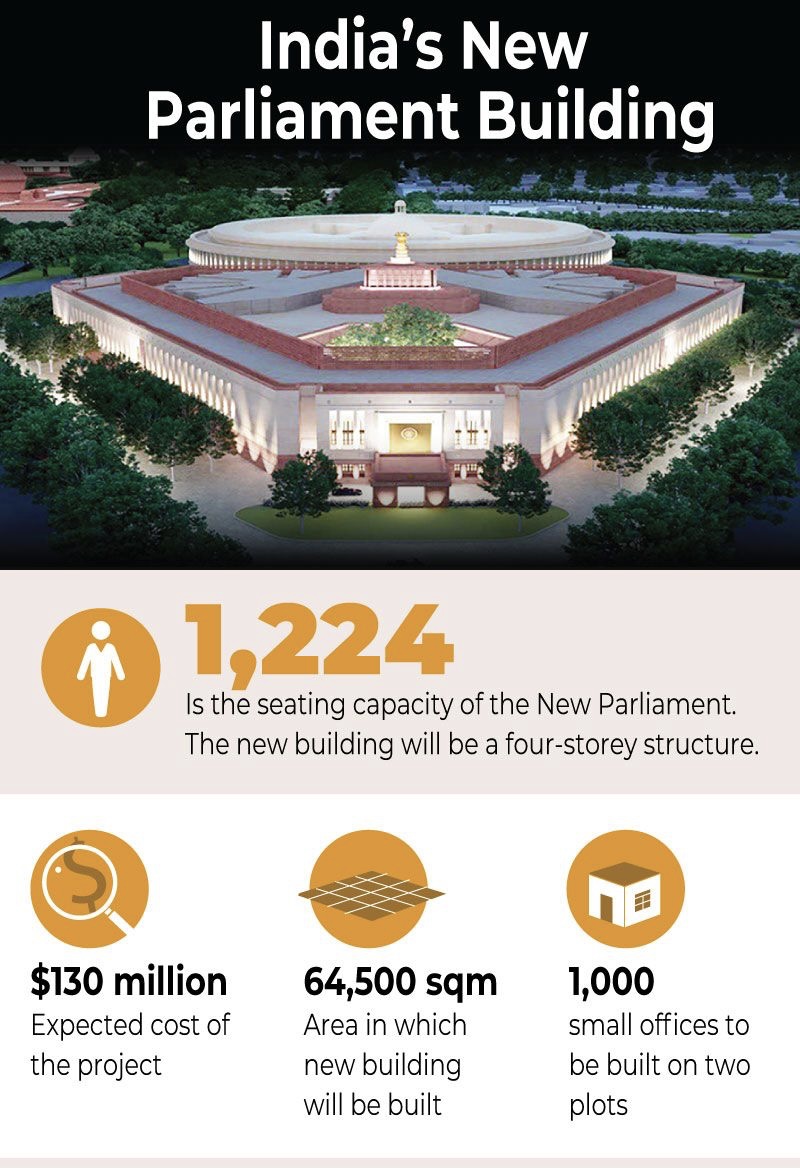Contents
- 1 Introduction
- 2 About the history of the New Parliament building
- 3 What is the need for the New Parliament building?
- 4 What are the main features of the New Parliament building?
- 5 What are the arguments supporting the development of the New Parliament building?
- 6 What are critics’ arguments against the construction of the New Parliament building?
- 7 What are the advantages associated with the development process of the New Parliament building?
- 8 What should be done?
| For 7PM Editorial Archives click HERE → |
Introduction
The recently inaugurated new Parliament building is a remarkable achievement and a symbol of the nation’s progress. It stands alongside the old Parliament House, embodying the aspirations and pride of the Indian people.
With increased seating capacity, advanced technology, and a blend of modernity and cultural heritage, the new building reflects India’s commitment to democracy and sustainability. It showcases impressive artwork, green building practices, and accessibility for all. This architectural marvel signifies a new era in India’s legislative journey.
About the history of the New Parliament building
July 2012: The need for a new Parliament building is proposed by the office of the then Lok Sabha Speaker, Meira Kumar. The existing building is deemed inadequate to meet the requirements of a growing democracy.
2020: The Central Vista redevelopment project, which includes the construction of a new Parliament building, is approved by the government. The project aims to revitalize the central administrative area of New Delhi.
In 2020: A petition was filed in the Delhi High Court challenging the Central Vista Redevelopment Project. Later, the Supreme Court transferred to itself the case from the Delhi High Court in “larger public interest”.
Dec 2020: The foundation stone for the new Parliament building is laid by Prime Minister.
In January 2021: A SC bench, by 2:1 majority, upheld the approvals and clearances granted for the Central Vista Project.
May 2023: The new Parliament building is completed and dedicated to the nation by Prime Minister. The inauguration ceremony takes place, marking the 75th year of India’s Independence.
What is the need for the New Parliament building?
Insufficient seating space for MPs: The current Parliament House was not designed to accommodate a bicameral legislature for a full-fledged democracy. The Central Hall can only seat 440 persons, which becomes a significant issue during Joint Sessions. Inadequate space for movement also poses a security risk.
Distressed infrastructure: Over time, modifications and additions to the existing building have led to issues such as water seepage, impacting aesthetics. The inclusion of services like water supply, sewer lines, air conditioning, fire safety equipment, and CCTV cameras has created challenges. Fire safety, in particular, is a major concern.
Outdated communication structures: The communication infrastructure and technology in the current Parliament House are outdated. Additionally, the acoustics of the halls require improvement.
Safety concerns: The current Parliament building was constructed when Delhi was in Seismic Zone-II. However, it is now located in Seismic Zone-IV, raising structural safety concerns.
Inadequate workspace for employees: Inner service corridors have been converted into offices over the years, resulting in poor-quality workspaces. Some of these workspaces have been further divided to accommodate additional workers, making them even smaller.
What are the main features of the New Parliament building?

Constitutional Hall: The building includes a state-of-the-art Constitutional Hall, emphasizing the importance of Indian citizens in the democratic process.
Modern facilities: The new building offers secure and efficient office spaces equipped with the latest communication technology. It features large committee rooms with advanced audio-visual equipment and provides an enhanced library experience.
Environmentally sustainable: The new Parliament building is designed as a “Platinum-rated Green Building,” demonstrating India’s commitment to environmental sustainability.
Reflecting Indian heritage: The building showcases the vibrance and diversity of modern India by incorporating cultural and regional arts and crafts, serving as an embodiment of Indian heritage.
What are the arguments supporting the development of the New Parliament building?

Infrastructure and technological upgrades: The new Parliament building addresses issues of inadequate seating capacity, office space, and outdated infrastructure in the old building. It incorporates state-of-the-art facilities, advanced communication systems, and electronic surveillance for improved functionality and efficiency.
Enhanced legislative proceedings: The new building provides well-engineered acoustics, a digitized voting system, and modern audiovisual systems to facilitate effective legislative proceedings. It ensures a more conducive environment for debates, discussions, and decision-making on matters of national importance.
Increased seating capacity: The new Parliament building can accommodate a larger number of Members of Parliament (MPs) and offers expanded seating capacity in both the Lok Sabha and Rajya Sabha chambers. This allows for a future increase in the number of MPs after the delimitation process.
Safety and security: The new building addresses safety concerns, particularly related to seismic safety and fire safety, ensuring the well-being of MPs and staff. It incorporates modern safety measures and infrastructure to mitigate risks and provide a secure environment for parliamentary activities.
Improved workspace and amenities: The new Parliament building offers improved workspaces for MPs, with well-designed offices and facilities. It provides better amenities, including comfortable seating, technological advancements, and dedicated spaces for meetings, committees, and libraries.
Symbolic and cultural significance: The new building represents the aspirations, pride, and culture of the Indian nation, embodying a sense of civilizational continuity. It showcases artwork, installations, and murals that celebrate India’s heritage, diversity, and achievements.
National pride and symbolism: The development of the new Parliament building is seen as a matter of national pride and a representation of India’s progress in the 21st century. It signifies India’s determination, resilience, and its commitment to democratic values and good governance.
| Read more: Functioning of Parliament: Challenges and way forward – Explained, pointwise |
What are critics’ arguments against the construction of the New Parliament building?
Cost and allocation of resources: Critics raise concerns about the substantial cost associated with constructing the new Parliament building, including expenses for interior decoration and artwork. They argue that these funds could have been utilized for more pressing needs, such as healthcare, education, or infrastructure development.
Lack of public consultation: The opposition express discontent over the lack of public consultation or involvement in the decision-making process regarding the construction of the new Parliament building. They argue that such a significant project should have involved broader discussions and considerations of public opinion.
Symbolism and controversial dates: Political analysts criticize the choice of the date and occasion for the inauguration of the new Parliament building, citing concerns about symbolism and the perceived prioritization of specific ideologies. They contend that a more inclusive and secular approach should have been taken to avoid potential controversies and division.
Superstition and cultural appropriateness: A well-known architect questions the decision-making process based on superstitious beliefs, such as adherence to Vastu regulations or the choice of an auspicious date, rather than pragmatic considerations. They argue that such decisions should be guided by practicality, inclusivity, and respect for diverse perspectives.
Public access and transparency: Some critics express concerns about limited public access to the new Parliament building and suggest that it could have been inaugurated as an open house, allowing citizens to explore and engage with the democratic institution.
Legacy and significance of the old building: Critics emphasize the historical and cultural significance of the old Parliament House and argue that its retirement to secondary functions diminishes its legacy. They contend that preserving the old building as a symbol of India’s democratic journey would have been a more appropriate approach.
What are the advantages associated with the development process of the New Parliament building?
Economic Boost: The construction of the new Parliament building contributes to economic growth by stimulating the construction industry. It boosted local and national economies.
Infrastructure Development: The new Parliament building is a significant addition to India’s infrastructure. It showcases the country’s commitment to modernity and progress, attracting attention and potential investments from domestic and international stakeholders. It serves as an iconic landmark that enhances the overall image and reputation of the nation.
Job Creation: The construction and subsequent functioning of the new Parliament building created employment opportunities across various sectors. From architects, engineers, and construction workers to maintenance staff, administrative personnel, and security personnel, it generates a diverse range of jobs that contribute to livelihoods and economic stability.
Tourism and Cultural Impact: The new Parliament building serves as a tourist attraction and a reflection of India’s cultural heritage. Its design, artwork, and integration of regional arts and crafts draw visitors, both domestic and international, stimulating tourism and promoting cultural exchange. This, in turn, generates revenue and supports local businesses in the hospitality and tourism sectors.
| Read more: Parliamentary debates: Significance, issues and the way forward – Explained, pointwise |
What should be done?
Public consultation and transparency: To address concerns about public involvement and transparency, it would be beneficial to engage in open discussions and consultations with the public regarding significant projects like the construction of the Parliament Building.
Preservation and renovation: Considering the historical and cultural significance of the old Parliament House, exploring options for its preservation and renovation should be considered.
The balance between tradition and modernity: Striking a balance between preserving heritage and incorporating modern elements can be achieved through architectural designs that reflect India’s rich cultural diversity while embracing technological advancements.
Emphasize public engagement: To foster a sense of ownership and connection with the democratic institution, provisions should be made to allow more public access to the Parliament building, such as guided tours or designated areas for public observation during sessions.
Sources: Times of India (Article 1 and Article 2), The Hindu, Indian Express (Article 1 and Article 2), PIB, Live Law and Hindustan Times
Syllabus: GS 1: Art & Culture: Salient aspects of Art Forms, literature and Architecture from ancient to modern times.
Discover more from Free UPSC IAS Preparation Syllabus and Materials For Aspirants
Subscribe to get the latest posts sent to your email.








